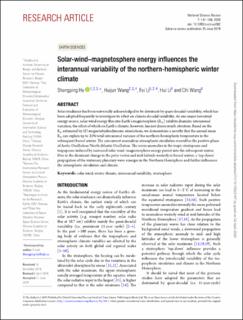Solar-wind–magnetosphere energy influences the interannual variability of the northern-hemispheric winter climate
Journal article, Peer reviewed
Published version

Åpne
Permanent lenke
https://hdl.handle.net/11250/2729125Utgivelsesdato
2020Metadata
Vis full innførselSamlinger
- Geophysical Institute [1198]
- Registrations from Cristin [9791]
Sammendrag
Solar irradiance has been universally acknowledged to be dominant by quasi-decadal variability, which has been adopted frequently to investigate its effect on climate decadal variability. As one major terrestrial energy source, solar-wind energy flux into Earth's magnetosphere (Ein) exhibits dramatic interannual variation, the effect of which on Earth's climate, however, has not drawn much attention. Based on the Ein estimated by 3D magnetohydrodynamic simulations, we demonstrate a novelty that the annual mean Ein can explain up to 25% total interannual variance of the northern-hemispheric temperature in the subsequent boreal winter. The concurrent anomalous atmospheric circulation resembles the positive phase of Arctic Oscillation/North Atlantic Oscillation. The warm anomalies in the tropic stratopause and tropopause induced by increased solar-wind–magnetosphere energy persist into the subsequent winter. Due to the dominant change in the polar vortex and mid-latitude westerly in boreal winter, a ‘top-down’ propagation of the stationary planetary wave emerges in the Northern Hemisphere and further influences the atmospheric circulation and climate.
